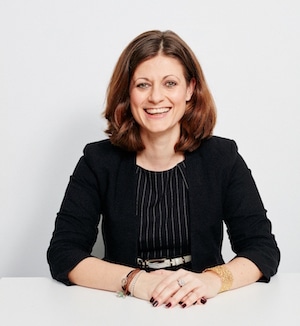
 
MyCheck, an obscure four-year-old Israeli company, creates custom apps that enables restaurant diners to view, split and pay their bill from their smartphone, without having to wait for or interact with a server.
Such seamless, ‘non-participatory’ experiences are coming to financial services.
“It’s not science fiction,” said Leda Glyptis, director at Sapient Global Markets. “The technology for all of this exists. What we don’t quite have is the organizational alignment to allow for people to wrap jobs and institutional awareness around it. It’s a journey, it’s a transition.”
Glyptis noted that financial services transactions are not done for fun or for the experience; rather, they are steps to something else, for example the provisioning of liquidity or credit or the investment of assets. As such, certain steps that are time-consuming, unpleasant or simply unnecessary can be eliminated.
For example, mobile GPS can trigger an automatic payment upon entrance to an art gallery, and a payment for additional insurance when an automobile crosses a national border. A vehicle’s leasing, financing and Internet-of-Things presence can be on blockchain’s distributed-ledger technology, which will automatically process payments, track mileage and depreciation, and lock down an ignition system if a payment is missed.
“All the services you’re currently consuming are integrated without people needing to call each other. It’s an easier, cheaper, more personalized experience,” Glyptis said. “It brings you as a consumer closer to whatever it is you are trying to do. Your bank partner and your insurance company are still your partners, but in that version of the future their organizations are smaller, leaner, and much more digitized.”
Financial institutions might initially resist seamless, “because invariably seamless looks like eliminating quite a lot of what makes them money and what they do all day. It’s extremely uncomfortable to imagine a world that doesn’t need you,” Glyptis added. “One of the things we do here is help people imagine not a world that doesn’t need them, but a world that consumes the value that they create very differently.”

Leda Glyptis, Sapient
In the business of wealth management specifically, the disruptive future presents a challenge to managers, as well as an opportunity, according to a 2015 World Economic Forum report.
“The emergence and growing popularity of automated wealth management services and customer empowerment tools will pose a tangible threat to the traditional practices of the wealth management industry,” the report stated. “However, incumbent institutions who can embrace these innovations and streamline their processes will be able to provide higher value services to a broader customer base.”
With regard to institutional brokerage, there is some expectation that the next evolution of algorithmic trading will depend on ‘smart’ machines, allowing a broader class of trades to benefit from automation and sophistication. Perhaps paradoxically, such a move to a more automated framework incorporating machine learning may prompt some push-back from the general public and regulators and result in a reversion to more manual processes.
“The development of smarter, faster machines in algorithmic trading will have varying implications on the market structure in terms of volume, liquidity, volatility and spread,” the WEF report said. “The future of algorithmic trading must be approached with a new lens with respect to the benefits it can deliver to the ecosystem weighed against the new types of risks it might create.”
Glyptis stressed that the future of disruption in financial services goes well beyond technology.
“When we talk about disruption, people start from a place of discomfort and naturally resort to a place of relative comfort,” she said. “When they look at disruption, digital disruption, they focus on the technology because there is a box named technology in their head, and a floor named technology in their organization, and if you give it a shape that you recognize, it’s easier to handle. But in regaining comfort, you lose nuance, and you lose the bigger picture.”
Featured image by Toh Kheng Ho/Photo Spin





